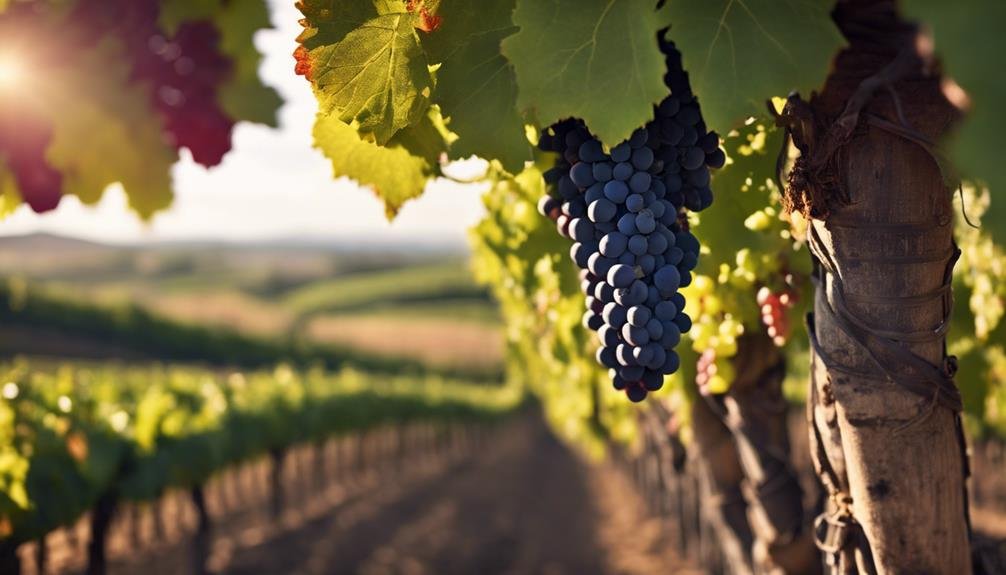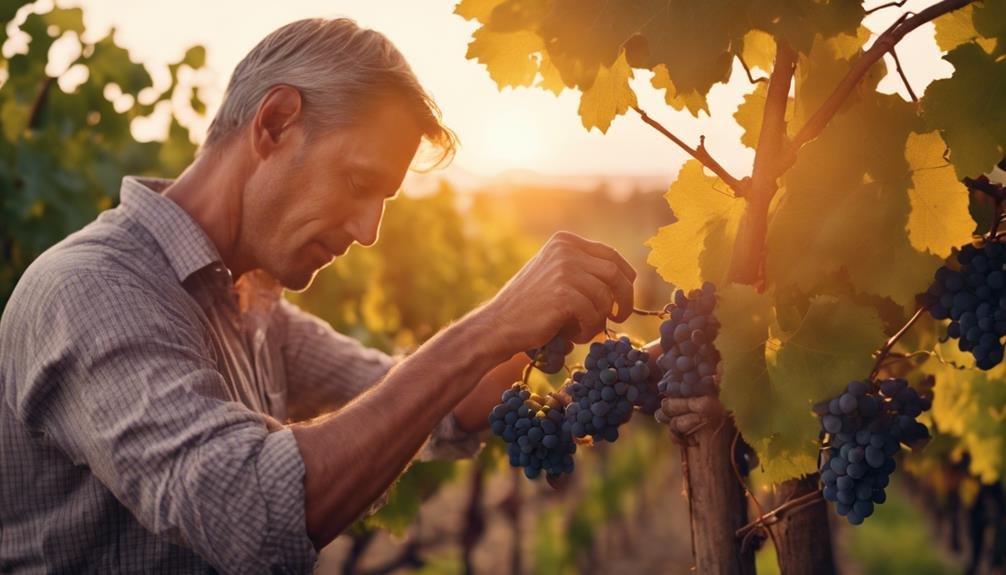Exceptional wine quality hinges on high-quality grapes at peak ripeness, crafted through precise growing techniques and sustainable practices. Terroir, a blend of climate, soil, and flora, shapes unique wine characteristics. Climate and soil dynamics play an important role in grape development, affecting flavors. Harvest timing impacts sugar levels and acidity, essential for flavor. The art of winemaking involves a delicate balance of science and craftsmanship, from grape selection to fermentation techniques. Revealing the secrets behind exceptional wine quality showcases a fusion of nature's intricacies and human expertise, paving the way for a journey into the world of fine wines.
Grape Quality and Wine Excellence
What critical role do high-quality grapes play in achieving wine excellence?
High-quality grapes are fundamental in crafting exceptional wines due to their impact on flavor profiles and the use of advanced growing techniques. Grapes with ideal ripeness and balanced sugar levels contribute to the complexity and depth of flavors in the wine.
Additionally, the meticulous care and attention given to cultivating these grapes through sustainable growing practices guarantee that only the finest fruit is harvested. By selecting the best grapes and employing precise growing techniques, winemakers can enhance the overall quality of the wine, resulting in a product that exhibits a harmonious blend of flavors and a true reflection of the vineyard's terroir.
Terroirs Impact on Wine Characteristics
The influence of terroir on wine characteristics is a pivotal factor that distinguishes exceptional wines through its nuanced expression of climate, soil, and flora. Terroir encapsulates the environmental factors that shape grape development, leading to a distinctive expression of the land in the final wine product.
Flora present in the vineyard plays an essential role in the development of wine, influencing factors such as aroma, flavor, and even the structure of the wine. Additionally, the presence of yeast on wine grapes contributes to the fermentation process, playing a key role in determining the final taste profile of the wine.
Understanding and harnessing the impact of terroir, including flora influence and yeast presence, is essential for creating wines of exceptional quality.
Climate and Soil Dynamics in Winemaking

In the intricate process of winemaking, the interplay between climate and soil dynamics stands as a pivotal cornerstone shaping the essence of exceptional wines. Soil composition plays a vital role in determining the quality of grapes, influencing the flavors and aromas of the final product. Different soil types, such as limestone, clay, or loam, impart distinct characteristics to the grapes grown in them.
Additionally, climate variability, including factors like temperature, rainfall, and sunlight exposure, directly impacts grape development and ripening. Understanding the relationship between soil composition and climate variability is essential for winemakers to cultivate grapes that reflect the unique terroir of a specific region.
Harvest Timing and Sustainable Practices
Optimizing harvest timing and integrating sustainable practices are pivotal factors in the cultivation of exceptional wines. Harvest precision guarantees grapes are picked at peak ripeness, essential for quality. Timing impacts sugar levels, acidity, and flavor development, influencing the final product.
Sustainable practices, like organic farming and biodiversity conservation, promote ideal sustainability. These methods help maintain soil health, preserve ecosystems, and produce higher quality grapes. Implementing permaculture techniques further enhances vineyard sustainability, benefitting both the environment and wine quality.
Unveiling the Art of Winemaking

Shifting from the emphasis on Harvest Timing and Sustainable Practices, an enlightening exploration into the intricate craftsmanship and creative ingenuity behind winemaking reveals a fascinating journey of artistry and skill. Winemaking involves a delicate balance of science and art, where skillful craftsmanship and artistic techniques converge to create exceptional wines. This artistry is exemplified through various processes, as shown in the table below:
| Process | Description |
|---|---|
| Grape Selection | Careful selection of the best grapes |
| Fermentation Techniques | Various methods to extract flavors |
| Barrel Aging | Maturation in different types of oak barrels |
| Blending | Mixing different wines to achieve desired taste |
| Bottling | Ensuring quality and preserving characteristics |
Each step showcases the expertise and creativity required in the art of winemaking.
Frequently Asked Questions
How Do Different Pruning Techniques Affect Grape Quality?
Different pruning techniques impact grape quality by influencing bud break, shoot thinning, and cluster thinning. Canopy management is vital for sunlight exposure and airflow, affecting grape development. Skilled pruning enhances vine health, fruit quality, and ultimately, wine excellence.
What Role Do Cover Crops Play in Enhancing Terroir Expression?
Cover crops act as nature's orchestra, harmonizing terroir notes. They enhance soil health, control erosion, and retain water, promoting sustainable agriculture and biodiversity. Just as a conductor guides musicians, cover crops orchestrate terroir expression.
Can Soil Ph Influence the Flavor Profile of a Wine?
Soil composition, particularly its pH or acidity levels, can greatly influence the flavor profile of a wine. The pH of the soil impacts the availability of nutrients to the grapevines, affecting grape development and ultimately the wine's taste characteristics.
Are There Specific Techniques for Hand-Harvesting Grapes Sustainably?
Hand-harvesting grapes sustainably involves meticulous selection, ensuring grape quality and vine health. Techniques include manual sorting, gentle handling to prevent damage, and adherence to sustainable practices. This method enhances the quality of grapes used in wine production.
How Can the Use of Amphorae Impact the Artistic Expression in Winemaking?
The use of amphorae in winemaking can enhance artistic expression by providing a unique vessel for fermentation and aging. These ancient clay vessels influence wine aesthetics, fostering winemaking creativity through their historical significance and distinctive visual appeal.
Conclusion
In the world of winemaking, the adage 'great wine requires a madman to grow the vine, a wise man to watch over it, a lucid poet to make it, and a lover to drink it' captures the essence of the intricate process behind exceptional wine quality.
From the careful selection of grapes to the influence of terroir and sustainable practices, the artistry and skill involved in crafting remarkable wines are truly a labor of love and dedication.